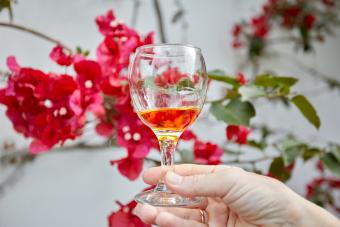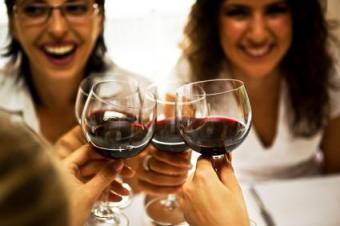
RichLegg / Getty Images E+ collection Wine and cheese
Novice and experienced wine drinkers share the need for basic wine knowledge, particularly when it comes to entertaining. With some basic knowledge and understanding, you can confidently select, buy, and serve wine.
Understanding Wine
Wine is made from fermented grape juice. Wines can be made from other fruits, as well, and these types of wines are usually labeled as fruit wine or the name of the fruit and wine, such as strawberry wine or blackberry wine. Winemaking has been around in some form or another for thousands of years, and it involves the fermentation of juice from the wine grapes or other fruits.
Wine Terminology
It helps in discussions of wine to understand the terminology associated with wine. Additionally, learning the terms used to describe wine's flavors and characteristics will help you understand more about it.
Vitis Vinifera
Wine is made from a specific type of grape known as vitis vinifera. These grapes are different from the table grapes you eat; they tend to be smaller and more concentrated than table grapes with less moisture. They also tend to have more seeds and thicker skins, and they are sweeter than table grapes because the sugars in the grape are needed to ferment into alcohol. Vitis vinifera are either black-skinned or bronze-skinned making red and white wines, respectively.
Wine Types
Wines can be broken down into various types:
- Red wines are made from black-skinned grapes and can range from dry to sweet. Red wines get their colors from the juice being left in contact with the skin for part of the winemaking process.
- White wines are made from bronze-skinned grapes and can range from dry to sweet.
- Blush or rosé wines are made mostly from black-skinned grapes or from a blend of bronze-skinned and black-skinned grapes.
- Orange wines are made from bronze-skinned grapes using the process for red wines; that is, leaving the juice in contact with the skin for part of the winemaking process. The result is an interesting white wine with red wine characteristics.

- Sparkling wines can be red, white, or rosé, although whites and rosés are the most common. Sparkling wines are made via various methods and include popular varieties such as Champagne, Prosecco, Sekt, and Cava among others. They can range from dry to sweet.
- Fortified wines are made by adding neutral grape spirits to wine to increase the alcohol level, and sometimes sugar is added. Wines such as Port and Sherry are fortified wines.
- Fortified aromatized wines are made by adding neutral grape spirits, botanicals, and possibly sugar to wine. Vermouth is a classic example of a fortified aromatized wine.
- Single varietal wines contain just one grape.
- Wine blends are made by blending different varietals together.
Sweetness
Wines range from dry, which means without sweetness or much residual sugar, to sweet. Most sweet wines are labeled as a sweet wine, late harvest wine, dessert wine, or ice wine, although some wines are characteristically sweet without being labeled as such, such as Moscato, Muscadine, and Port.
Vintage
The vintage is the year in which the wine grapes were harvested. Wines can either be labeled as vintage or non-vintage. Vintage wines will have a date listed on the wine label, while non-vintage wines will either be labeled as NV or simply have no vintage listed. A majority of red, white, and rosé wines have a vintage listed. Sparkling wines, fortified wines such as Port, and some dessert wines may be either vintage or non-vintage.
How Wine Is Labeled
You will typically find wines labeled in one of three ways:
- Wines labeled by varietal have the name of the grape varietal used in the wine. For example, Cabernet Sauvignon and Chardonnay are varietal labeled wines named for the grape they contain. By law, varietal-labeled wines from the United States must contain 75 percent of the named varietal. Wines from the rest of the world must contain 85 percent of the named varietal to be labeled this way.
- Wines can also be labeled by region. This is common in Old World style wines from France, Italy, and Spain such as Bordeaux, Champagne, Priorat, or Chianti. When wines are labeled by region, it typically means the grapes were grown in that region and they contain a single varietal or blend of specific grapes. For example, Bordeaux wines contain grapes such as Cabernet Sauvignon, Cabernet Franc, and Merlot while red Burgundy wines contain Pinot Noir and white Burgundies contain Chardonnay.
- Some wines are also "named." These wines may have names such as Penfold's Grange, which is a Shiraz wine that may have some Cabernet Sauvignon blended in. They may also be named after the vineyard in which the grapes are grown.

fcafotodigital / E+ / Getty Images / Modifications made by Inês Saldanha for LoveToKnow Wine bottles packed in a wooden box
Tasting and Drinking Wine
When you taste wine, you'll notice several key aspects about it.
- Body describes the viscosity of the wine.
- Acidity describes tart or "sour" flavors in wine.
- Tannins add bitterness and astringency to the wine and also allow wines to age.
- Alcohol adds a "hotness" to the wine; it is the result of fermentation. Alcohol is measured by volume or ABV. In general, wine has an ABV ranging from about 5.5 percent to 23 percent for some fortified wines.
- Sweetness is how you perceive the sugar in the wine. Wine can be very dry, very sweet, or anywhere in between.
- Aromas are the fragrances you smell in the wine. They also affect how the wine tastes. Aromas come in a wide range including floral, herbal, earthy, fruity, or spicy.
- Flavors are the way the wine tastes on your tongue. Flavors may be any of the aromas, and they may also include meaty, buttery, salty, oaky, or vegetal.
- Finish describes how the wine lingers on the palate and what flavors come after drinking the wine.
Expert Wine Selection Tips
LoveToKnow Wine interviewed Laurie Forster, Wine Coach and author of The Sipping Point: A Crash Course in Wine. Laurie is certified in Viticulture and Vinification from the American Sommelier Association, and she shared her tips for selecting, buying, and serving wine.
Choosing Wine for a Dinner
When it comes to serving a wine for dinner, finding the right food pairing can help. According to Forster, "I believe it is always best to have options. That being said, I sometimes choose a wine pairing for each course of the meal but let guests have two glasses each so they can taste your selections with multiple courses. So, even if the Cabernet Sauvignon was the pairing for the beef, they can drink it with the fish if they like." She also recommends selecting a sparkling wine, a white, a red, and a dessert wine for a dinner party.
Food Pairing Rules
While there are no "rules" for pairing wine with food (drink what you like with what you eat), a great food and wine pairing can bring out the best in both components. Forster recommends pairing heavier foods with heavier wines and lighter foods with lighter wines. "This is pretty intuitive," she notes. "For instance, a crisp summer seafood salad would be overwhelmed by a hearty Cabernet Sauvignon. A light, fruity Pinot Grigio would be lost paired with a New York strip steak."

Wines for a Party
At a party, Forster recommends some safe bets due to their popularity:
- Choose Chardonnay or Pinot Grigio for whites.
- Choose Merlot or Cabernet Sauvignon for reds.
- For an affordable sparkling wine, choose Prosecco or Spanish Cava.
As to how much wine to buy, Forster makes the following suggestion: "For a cocktail party, assume each wine-drinking guest will consume a five-ounce glass every hour. If you've invited 20 wine-drinkers and plan a two-hour party, that's five ounces per hour times two hours, so each person will drink 10 ounces. Now multiply 10 ounces by 20 guests, which equals 200 ounces needed, divided by 25 (approximate number of ounces in a bottle) equals eight bottles."
Forster also notes wine stores often offer discounts for purchasing a case or more, so you may want to consider buying a case with the few extra bottles. If you don't want to do math, she suggests a rough rule of thumb, which is one bottle of wine per person.
Serving Wine
The type of wine determines the best way to serve it.
- In general, red wines should be served at slightly below room temperature; about 60°F to 65°F according to Forster.
- White wines are better chilled. Forster notes you should serve them at between 45°F and 50°F.
- Sparkling wines should be even cooler, at about 40°F to 45°F.
Consult a wine temperature chart for specific wines. You can chill wines rapidly by soaking the bottle in a mix of ice and water for about 20 minutes.
Decanting
It isn't necessary to decant wines, but Forster describes two situations where decanting is necessary. "One is to remove the sediment, which is more often found in wines with ten or more years of bottle age and older vintage ports," Forster notes. "The other reason is to soften young tannic wines, like Cabernet Sauvignon, through aeration. The astringent or dry finish you get from these youthful reds will soften with decanting."
Wine Glasses
You don't need to buy fancy stemware to serve your wine, although there are glasses designed specifically for different types of wine. Different types of wine glasses can enhance your enjoyment by directing its aromas appropriately and depositing the wine on certain areas of your tongue to help you perceive its flavor nuances. As long as you have basic wine glasses - either with stems or without - then you're good to go. If you'd like to match your glasses to the wines you serve, you can purchase specific glasses.

Apply What You Know
Applying the expert tips and suggestions presented here can help you make informed decisions and allow you to select, purchase and choose wine with confidence. And you can celebrate your new understanding with these fun wine quotes and captions. With a little wine knowledge, you'll soon be picking and serving wines like a pro.







